The Inflation Reduction Act will help the US cut emissions to approximately 40% below 2005 levels by 2030, putting the national target of a 50-52% reduction in reach. Here’s how the country can get all the way there.
After Inflation Reduction Act: 5 Ways to Hit the US Emissions Goal
Author: Dan Lashof
URL: https://www.wri.org/insights/inflation-reduction-act-emissions-gap
As millions of Americans suffered through [record heatwaves](https://www.usatoday.com/story/news/nation/2022/07/10/high-temperatures-heat-dome-break-records/10023708002/) and [devastating floods](https://www.theguardian.com/us-news/2022/aug/11/america-summer-floods-rainfall-climate-crisis) this summer, Congress finally responded to the climate crisis with a major investment in solutions. The Inflation Reduction Act is the most significant federal climate legislation ever enacted in the United States, providing $370 billion over 10 years to support clean electricity, electric vehicles, heat pumps and more.
Analysis from multiple groups ([here](https://repeatproject.org/), [here](https://energyinnovation.org/resources/our-publications/) and [here](https://rhg.com/research/inflation-reduction-act/)) shows that this legislation could help the country cut emissions to approximately 40% below 2005 levels by 2030. That’s huge progress towards the U.S. goal of slashing emissions [50-52% by 2030](https://www.wri.org/insights/6-words-biden-us-target-ghg-emissions-reduction).
Here are five actions the U.S. federal government, states, cities and the private sector can take to help close the post-Inflation Reduction Act emissions gap:
1) Deploy Clean Vehicles.
Cars and trucks are the largest source of greenhouse gases in the United States. The U.S. Environmental Protection Agency (EPA) has clear authority to set standards that can not only reduce these emissions, but also save consumers money in fuel costs.
Implementation of the [National Electric Vehicle Infrastructure](https://www.fhwa.dot.gov/bipartisan-infrastructure-law/nevi_formula_program.cfm) program can help support states’ EV transition. The Bipartisan Infrastructure Law provides $5 billion for states to build a [fast-charging network](https://www.wri.org/insights/funding-us-ev-charging-infrastructure), with stations located every 50 miles along major highway corridors. States can help the U.S. achieve greater emissions reductions by making full use of this program and adopting standards to require that all passenger vehicle sales be zero-emissions by 2035.
2) Generate Clean Power.
Power plants were the largest source of greenhouse gas emissions in the United States until 2016, when coal plant retirements and increases in wind and solar generation reduced emissions below those of the transport sector. The Inflation Reduction Act will greatly accelerate these trends, leading to as much as an 80% reduction in power sector emissions in 2030 compared with 2005 levels.
States can go further by setting 100% clean electricity standards, as 20 states have already done. And cities and private companies can contract to purchase 100% clean power on a 24/7/365 basis, which will make progress toward a fully clean electricity system.
3) Connect Consumers to Clean Power.
The Federal Energy Regulatory Commission (FERC) is an independent agency that has traditionally worked on a bipartisan basis to ensure that electricity markets and infrastructure enable all resources to compete. As part of its legal duty, FERC must remove barriers to newer, emissions-free technologies, allowing them to access the markets and transmission networks on an equal basis as traditional power plants.
4) Expand State and Local Climate Action.
States and cities can work in partnership with the federal government to implement an all-in climate strategy that reduces emissions well beyond what the federal government can achieve alone.
State and local actors will play an essential role in helping the nation as a whole reach its 2030 climate goal because they [control several policy levers](https://www.wri.org/research/new-climate-federalism-defining-federal-state-and-local-roles-us-policy-framework-achieve) to reduce emissions. State public utility commissions, for instance, regulate investor-owned utilities and can [play a pivotal role](https://rmi.org/the-untapped-potential-of-public-utility-commissions/) in enabling a zero-carbon grid. State and local governments can [focus their transportation investments](https://www.wri.org/insights/clean-transportation-us-bipartisan-infrastructure-law) on repairing existing roads rather than expanding them in ways that increase driving. They can also improve public transit and adopt land use planning, permitting and housing policies that reduce the need to drive.
5) Redirect Private Investment to Climate Action
The Inflation Reduction Act will provide strong incentives for the private sector to invest in emissions-reducing technologies — from battery manufacturing to systems that capture carbon dioxide directly from the atmosphere — but how aggressively companies respond to those incentives will have a big impact on how quickly emissions are reduced. Most of the incentives in the Inflation Reduction Act are through the tax code and their total value is not capped. This means that if companies and individuals respond to these incentives more than the Congressional Budget Office assumed, the total value of the clean energy investments from the Inflation Reduction Act could exceed $370 billion and further reduce emissions.
Using Every Available Means to Reduce US Emissions
These additional actions by the federal government, states, cities and the private sector will be critical to achieving the U.S. 50-52% emissions-reduction target.
The United States must use every available tool to tackle climate change or it will fall behind other countries taking advantage of the new climate economy. Fully executing the Inflation Reduction Act —and going beyond it — can help create a future that is prosperous, equitable and secure.



0 Comments